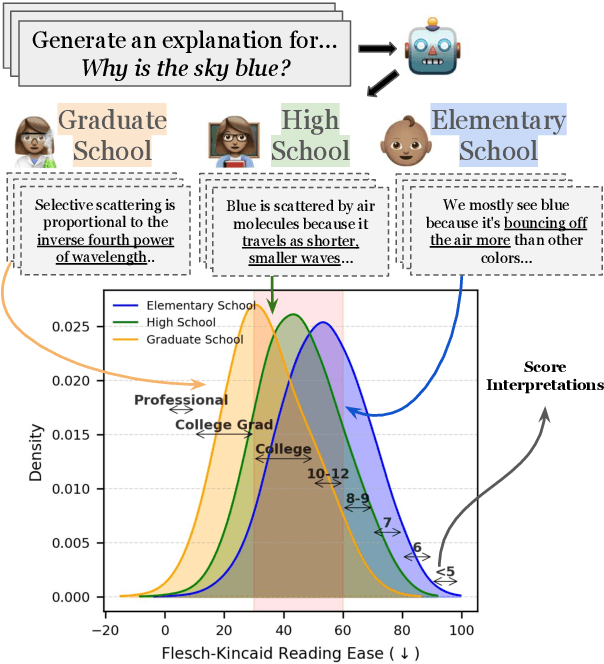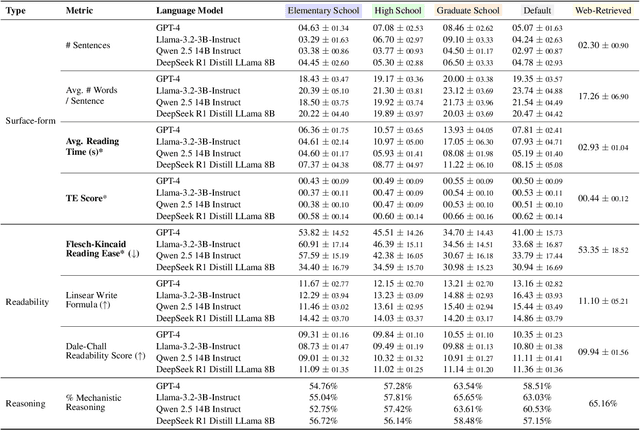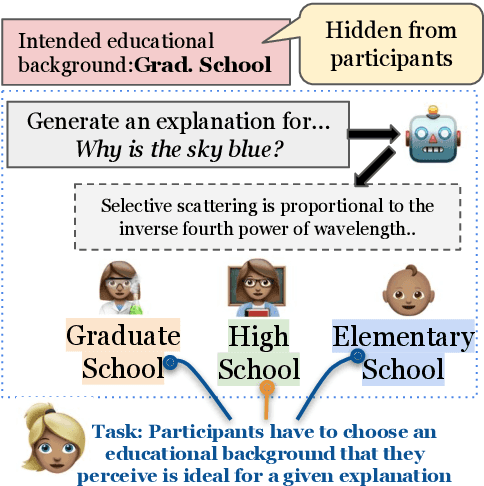Xiang Ren
ELI-Why: Evaluating the Pedagogical Utility of Language Model Explanations
Jun 17, 2025



Abstract:Language models today are widely used in education, yet their ability to tailor responses for learners with varied informational needs and knowledge backgrounds remains under-explored. To this end, we introduce ELI-Why, a benchmark of 13.4K "Why" questions to evaluate the pedagogical capabilities of language models. We then conduct two extensive human studies to assess the utility of language model-generated explanatory answers (explanations) on our benchmark, tailored to three distinct educational grades: elementary, high-school and graduate school. In our first study, human raters assume the role of an "educator" to assess model explanations' fit to different educational grades. We find that GPT-4-generated explanations match their intended educational background only 50% of the time, compared to 79% for lay human-curated explanations. In our second study, human raters assume the role of a learner to assess if an explanation fits their own informational needs. Across all educational backgrounds, users deemed GPT-4-generated explanations 20% less suited on average to their informational needs, when compared to explanations curated by lay people. Additionally, automated evaluation metrics reveal that explanations generated across different language model families for different informational needs remain indistinguishable in their grade-level, limiting their pedagogical effectiveness.
Amulet: Putting Complex Multi-Turn Conversations on the Stand with LLM Juries
May 26, 2025Abstract:Today, large language models are widely used as judges to evaluate responses from other language models. Hence, it is imperative to benchmark and improve these LLM-judges on real-world language model usage: a typical human-assistant conversation is lengthy, and shows significant diversity in topics, intents, and requirements across turns, e.g. social interactions, task requests, feedback. We present Amulet, a framework that leverages pertinent linguistic concepts of dialog-acts and maxims to improve the accuracy of LLM-judges on preference data with complex, multi-turn conversational context. Amulet presents valuable insights about (a) the communicative structures and intents present in the conversation (dialog acts), and (b) the satisfaction of conversational principles (maxims) by the preference responses, and uses them to make judgments. On four challenging datasets, Amulet shows that (a) humans frequently (60 to 70 percent of the time) change their intents from one turn of the conversation to the next, and (b) in 75 percent of instances, the preference responses can be differentiated via dialog acts and/or maxims, reiterating the latter's significance in judging such data. Amulet can be used either as a judge by applying the framework to a single LLM, or integrated into a jury with different LLM judges; our judges and juries show strong improvements on relevant baselines for all four datasets.
Improving LLM Personas via Rationalization with Psychological Scaffolds
Apr 25, 2025Abstract:Language models prompted with a user description or persona can predict a user's preferences and opinions, but existing approaches to building personas -- based solely on a user's demographic attributes and/or prior judgments -- fail to capture the underlying reasoning behind said user judgments. We introduce PB&J (Psychology of Behavior and Judgments), a framework that improves LLM personas by incorporating rationales of why a user might make specific judgments. These rationales are LLM-generated, and aim to reason about a user's behavior on the basis of their experiences, personality traits or beliefs. This is done using psychological scaffolds -- structured frameworks grounded in theories such as the Big 5 Personality Traits and Primal World Beliefs -- that help provide structure to the generated rationales. Experiments on public opinion and movie preference prediction tasks demonstrate that LLM personas augmented with PB&J rationales consistently outperform methods using only a user's demographics and/or judgments. Additionally, LLM personas constructed using scaffolds describing user beliefs perform competitively with those using human-written rationales.
Stepwise Informativeness Search for Improving LLM Reasoning
Feb 21, 2025Abstract:Advances in Large Language Models (LLMs) have significantly improved multi-step reasoning through generating free-text rationales. However, recent studies show that LLMs tend to lose focus over the middle of long contexts. This raises concerns that as reasoning progresses, LLMs may overlook information in earlier steps when decoding subsequent steps, leading to generate unreliable and redundant rationales. To address this, we propose guiding LLMs to generate more accurate and concise step-by-step rationales by (1) proactively referencing information from underutilized prior steps, and (2) minimizing redundant information between new and existing steps. We introduce stepwise informativeness search, an inference-time tree search framework incorporating two selection heuristics: grounding-guided selection which prioritizes steps paying higher attention over underutilized steps; and novelty-guided selection which encourages steps with novel conclusions. During rationale generation, we use a self-grounding strategy that prompts LLMs to explicitly reference relevant prior steps to provide premises before deduction at each step. Experimental results on four reasoning datasets demonstrate that our approach improves reasoning accuracy by generating higher-quality rationales with reduced errors and redundancy.
REALTALK: A 21-Day Real-World Dataset for Long-Term Conversation
Feb 18, 2025Abstract:Long-term, open-domain dialogue capabilities are essential for chatbots aiming to recall past interactions and demonstrate emotional intelligence (EI). Yet, most existing research relies on synthetic, LLM-generated data, leaving open questions about real-world conversational patterns. To address this gap, we introduce REALTALK, a 21-day corpus of authentic messaging app dialogues, providing a direct benchmark against genuine human interactions. We first conduct a dataset analysis, focusing on EI attributes and persona consistency to understand the unique challenges posed by real-world dialogues. By comparing with LLM-generated conversations, we highlight key differences, including diverse emotional expressions and variations in persona stability that synthetic dialogues often fail to capture. Building on these insights, we introduce two benchmark tasks: (1) persona simulation where a model continues a conversation on behalf of a specific user given prior dialogue context; and (2) memory probing where a model answers targeted questions requiring long-term memory of past interactions. Our findings reveal that models struggle to simulate a user solely from dialogue history, while fine-tuning on specific user chats improves persona emulation. Additionally, existing models face significant challenges in recalling and leveraging long-term context within real-world conversations.
Attributing Culture-Conditioned Generations to Pretraining Corpora
Dec 30, 2024



Abstract:In open-ended generative tasks like narrative writing or dialogue, large language models often exhibit cultural biases, showing limited knowledge and generating templated outputs for less prevalent cultures. Recent works show that these biases may stem from uneven cultural representation in pretraining corpora. This work investigates how pretraining leads to biased culture-conditioned generations by analyzing how models associate entities with cultures based on pretraining data patterns. We propose the MEMOed framework (MEMOrization from pretraining document) to determine whether a generation for a culture arises from memorization. Using MEMOed on culture-conditioned generations about food and clothing for 110 cultures, we find that high-frequency cultures in pretraining data yield more generations with memorized symbols, while some low-frequency cultures produce none. Additionally, the model favors generating entities with extraordinarily high frequency regardless of the conditioned culture, reflecting biases toward frequent pretraining terms irrespective of relevance. We hope that the MEMOed framework and our insights will inspire more works on attributing model performance on pretraining data.
Hybrid Forecasting of Geopolitical Events
Dec 14, 2024



Abstract:Sound decision-making relies on accurate prediction for tangible outcomes ranging from military conflict to disease outbreaks. To improve crowdsourced forecasting accuracy, we developed SAGE, a hybrid forecasting system that combines human and machine generated forecasts. The system provides a platform where users can interact with machine models and thus anchor their judgments on an objective benchmark. The system also aggregates human and machine forecasts weighting both for propinquity and based on assessed skill while adjusting for overconfidence. We present results from the Hybrid Forecasting Competition (HFC) - larger than comparable forecasting tournaments - including 1085 users forecasting 398 real-world forecasting problems over eight months. Our main result is that the hybrid system generated more accurate forecasts compared to a human-only baseline which had no machine generated predictions. We found that skilled forecasters who had access to machine-generated forecasts outperformed those who only viewed historical data. We also demonstrated the inclusion of machine-generated forecasts in our aggregation algorithms improved performance, both in terms of accuracy and scalability. This suggests that hybrid forecasting systems, which potentially require fewer human resources, can be a viable approach for maintaining a competitive level of accuracy over a larger number of forecasting questions.
* 20 pages, 6 figures, 4 tables
Diverging Preferences: When do Annotators Disagree and do Models Know?
Oct 18, 2024



Abstract:We examine diverging preferences in human-labeled preference datasets. We develop a taxonomy of disagreement sources spanning 10 categories across four high-level classes -- task underspecification, response style, refusals, and annotation errors. We find that the majority of disagreements are in opposition with standard reward modeling approaches, which are designed with the assumption that annotator disagreement is noise. We then explore how these findings impact two areas of LLM development: reward modeling and evaluation. In our experiments, we demonstrate how standard reward modeling methods, like the Bradley-Terry model, fail to differentiate whether a given preference judgment is the result of unanimous agreement among annotators or the majority opinion among diverging user preferences. We also find that these tendencies are also echoed by popular LLM-as-Judge evaluation methods, which consistently identify a winning response in cases of diverging preferences. These findings highlight remaining challenges in LLM evaluations, which are greatly influenced by divisive features like response style, and in developing pluralistically aligned LLMs. To address these issues, we develop methods for identifying diverging preferences to mitigate their influence on evaluation and training.
WildVis: Open Source Visualizer for Million-Scale Chat Logs in the Wild
Sep 05, 2024Abstract:The increasing availability of real-world conversation data offers exciting opportunities for researchers to study user-chatbot interactions. However, the sheer volume of this data makes manually examining individual conversations impractical. To overcome this challenge, we introduce WildVis, an interactive tool that enables fast, versatile, and large-scale conversation analysis. WildVis provides search and visualization capabilities in the text and embedding spaces based on a list of criteria. To manage million-scale datasets, we implemented optimizations including search index construction, embedding precomputation and compression, and caching to ensure responsive user interactions within seconds. We demonstrate WildVis's utility through three case studies: facilitating chatbot misuse research, visualizing and comparing topic distributions across datasets, and characterizing user-specific conversation patterns. WildVis is open-source and designed to be extendable, supporting additional datasets and customized search and visualization functionalities.
Rethinking Backdoor Detection Evaluation for Language Models
Aug 31, 2024



Abstract:Backdoor attacks, in which a model behaves maliciously when given an attacker-specified trigger, pose a major security risk for practitioners who depend on publicly released language models. Backdoor detection methods aim to detect whether a released model contains a backdoor, so that practitioners can avoid such vulnerabilities. While existing backdoor detection methods have high accuracy in detecting backdoored models on standard benchmarks, it is unclear whether they can robustly identify backdoors in the wild. In this paper, we examine the robustness of backdoor detectors by manipulating different factors during backdoor planting. We find that the success of existing methods highly depends on how intensely the model is trained on poisoned data during backdoor planting. Specifically, backdoors planted with either more aggressive or more conservative training are significantly more difficult to detect than the default ones. Our results highlight a lack of robustness of existing backdoor detectors and the limitations in current benchmark construction.
 Add to Chrome
Add to Chrome Add to Firefox
Add to Firefox Add to Edge
Add to Edge